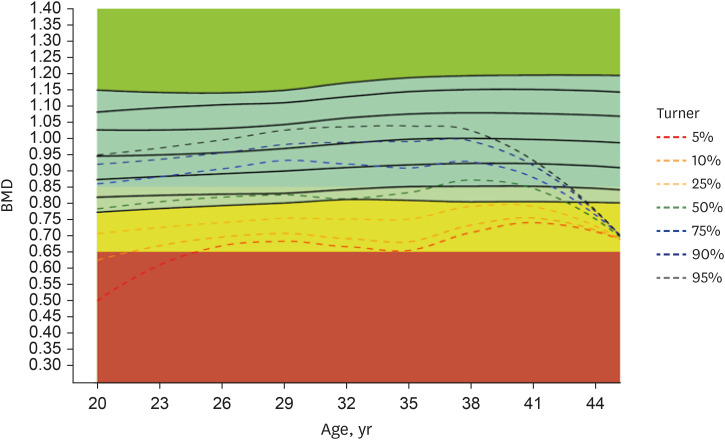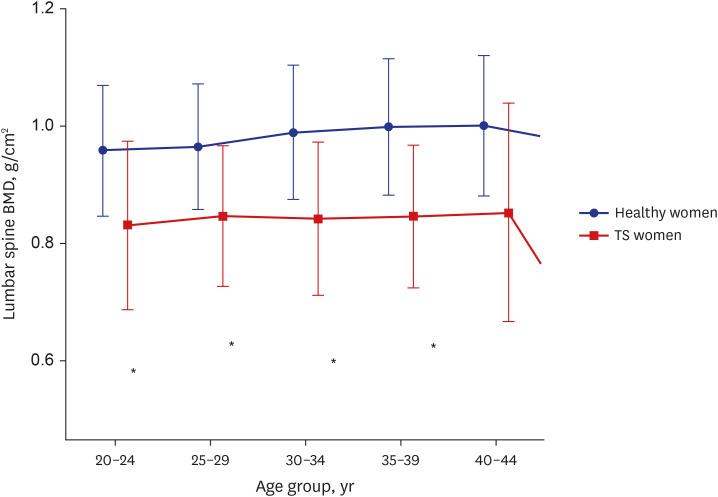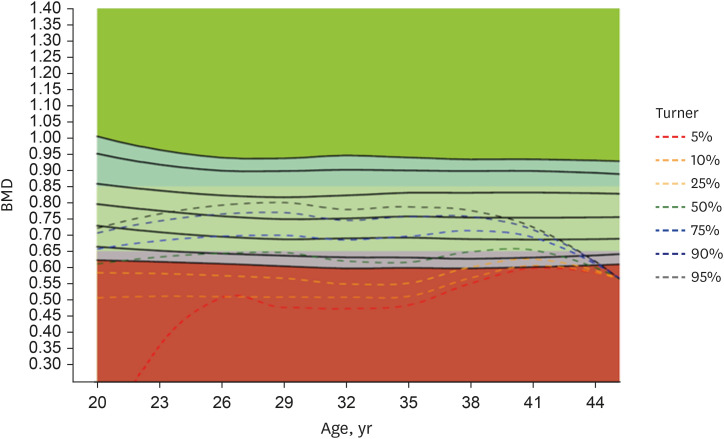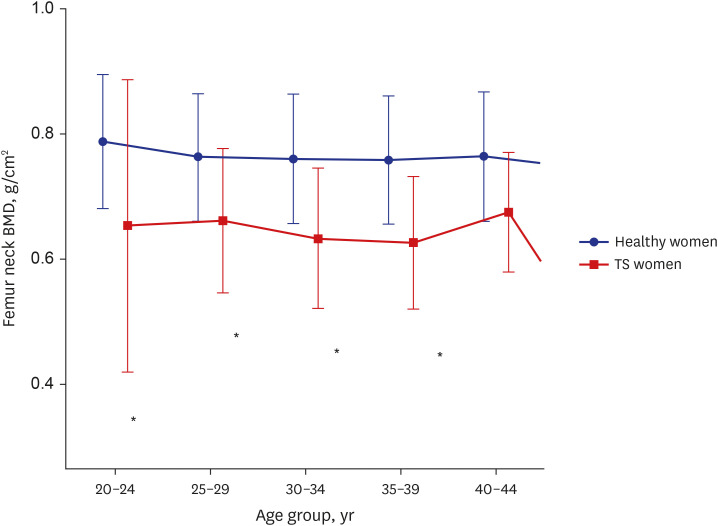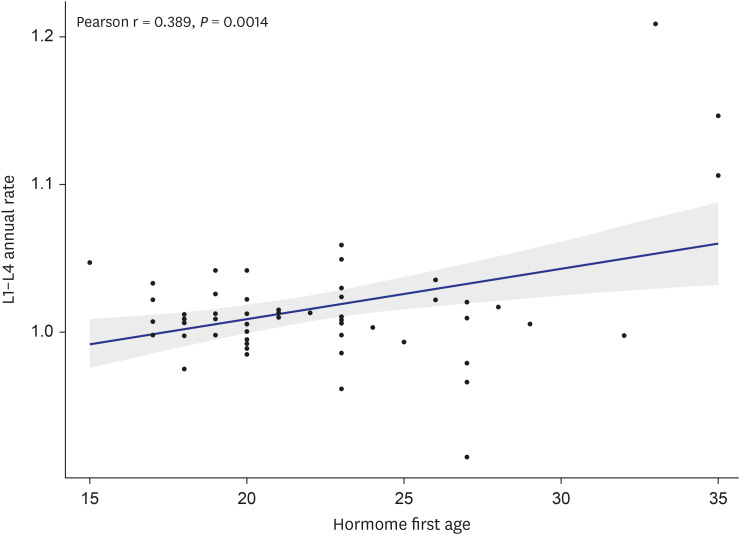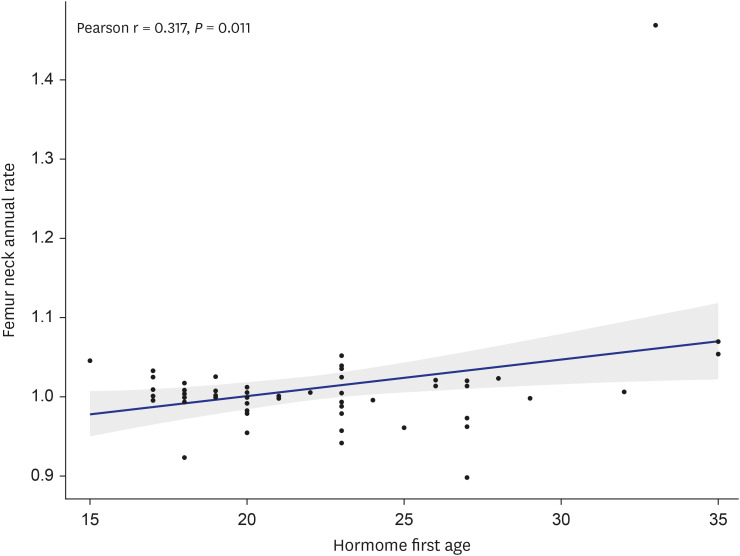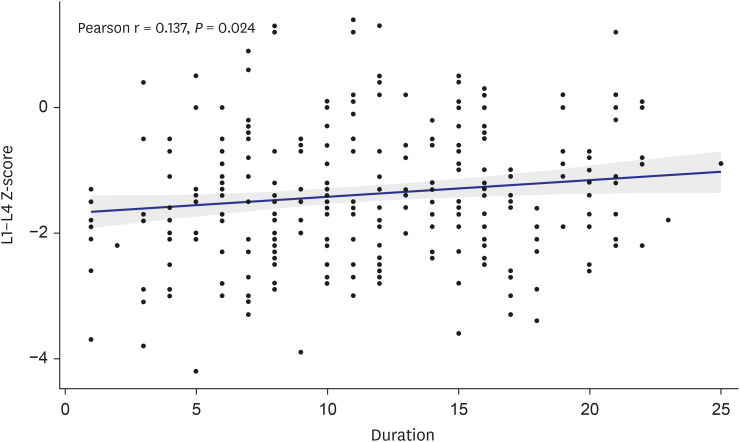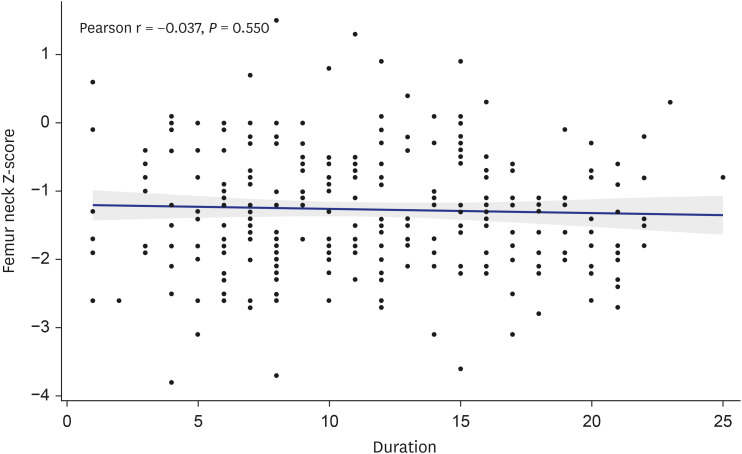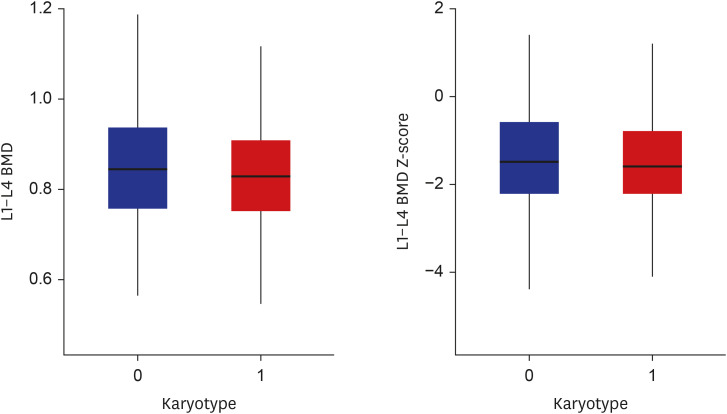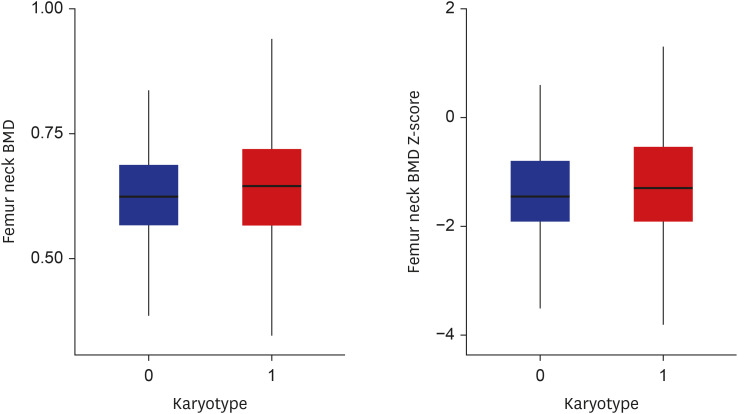J Korean Med Sci.
2024 Jan;39(1):e9. 10.3346/jkms.2024.39.e9.
Effects of Hormone Replacement Therapy on Bone Mineral Density in Korean Adults With Turner Syndrome
- Affiliations
-
- 1Dream Foret Obstetrics and Gynecology, Jeju, Korea
- 2Department of Obstetrics and Gynecology, Severance Hospital, Yonsei University College of Medicine, Seoul, Korea
- 3Institute of Women’s Life Medical Science, Yonsei University College of Medicine, Seoul, Korea
- 4Department of Obstetrics and Gynecology, Gangnam Severance Hospital, Yonsei University College of Medicine, Seoul, Korea
- 5Department of Statistics, University of Seoul, Seoul, Korea
- KMID: 2550796
- DOI: http://doi.org/10.3346/jkms.2024.39.e9
Abstract
- Background
Turner syndrome (TS) is a common chromosomal abnormality, which is caused by loss of all or part of one X chromosome. Hormone replacement therapy in TS is important in terms of puberty, growth and prevention of osteoporosis however, such a study has never been conducted in Korea. Therefore, the purpose of our study was to determine relationship between the starting age, duration of estrogen replacement therapy (ERT) in TS and develop a hormone replacement protocol suitable for the situation in Korea.
Methods
This is retrospective study analyzed the medical records in TS patients treated at the Severance hospital, Yonsei University College of Medicine, Seoul, Korea from 1997 to 2019. Total of 188 subjects who had received a bone density test at least once were included in the study. Korean National Health and Nutrition Examination Survey (KNHANES) was used for achieving bone mineral density (BMD) of normal control group. Student’s t-test, MannWhitney U test, ANOVA and correlation analysis were performed using SPSS 18.0.
Results
Each BMD measurement was significantly lower in women with TS than in healthy Korean women. Early start and longer duration of ERT is associated with higher lumbar spine BMD but not femur neck BMD. Femur neck BMD, but not lumbar spine BMD was significantly higher in women with mosaicism than 45XO group.
Conclusion
Early onset and appropriate duration of hormone replacement therapy is important for increasing bone mineral density in patients with Turner syndrome. Also, ERT affects differently to TS patients according to mosaicism.
Figure
Reference
-
1. Gravholt CH, Andersen NH, Conway GS, Dekkers OM, Geffner ME, Klein KO, et al. Clinical practice guidelines for the care of girls and women with Turner syndrome: proceedings from the 2016 Cincinnati International Turner Syndrome Meeting. Eur J Endocrinol. 2017; 177(3):G1–70. PMID: 28705803.2. Stochholm K, Juul S, Juel K, Naeraa RW, Gravholt CH. Prevalence, incidence, diagnostic delay, and mortality in Turner syndrome. J Clin Endocrinol Metab. 2006; 91(10):3897–3902. PMID: 16849410.3. Viuff MH, Stochholm K, Uldbjerg N, Nielsen BB, Gravholt CH. Danish Fetal Medicine Study Group. Only a minority of sex chromosome abnormalities are detected by a national prenatal screening program for Down syndrome. Hum Reprod. 2015; 30(10):2419–2426. PMID: 26251461.4. Alpman A, Cogulu O, Akgul M, Arikan EA, Durmaz B, Karaca E, et al. Prenatally diagnosed Turner syndrome and cystic hygroma: incidence and reasons for referrals. Fetal Diagn Ther. 2009; 25(1):58–61. PMID: 19202339.5. Bondy CA. Turner Syndrome Study Group. Care of girls and women with Turner syndrome: a guideline of the Turner Syndrome Study Group. J Clin Endocrinol Metab. 2007; 92(1):10–25. PMID: 17047017.6. Kim SE, Park SH, Han K, Cho WK, Suh BK, Park YG. Population Prevalence, Cancer Risk, and Mortality Risk of Turner Syndrome in South Korean Women Based on National Health Insurance Service Data. Yonsei Med J. 2022; 63(11):991–998. PMID: 36303307.7. Bondy CA. Turner syndrome 2008. Horm Res. 2009; 71(Suppl 1):52–56.8. Hjerrild BE, Mortensen KH, Gravholt CH. Turner syndrome and clinical treatment. Br Med Bull. 2008; 86(1):77–93. PMID: 18400842.9. Balasch J. Sex steroids and bone: current perspectives. Hum Reprod Update. 2003; 9(3):207–222. PMID: 12859043.10. Riggs BL, Khosla S, Melton LJ 3rd. Sex steroids and the construction and conservation of the adult skeleton. Endocr Rev. 2002; 23(3):279–302. PMID: 12050121.11. Lim SK, Lee NH, Lee JH, Choi MS, Chung YS, Ahn KJ, et al. Peak bone mass and affecting factors in Korean women. Yonsei Med J. 1993; 34(1):57–62. PMID: 8379183.12. Lee SR, Cho MK, Cho YJ, Chun S, Hong SH, Hwang KR, et al. The 2020 menopausal hormone therapy guidelines. J Menopausal Med. 2020; 26(2):69–98. PMID: 32893509.13. Friedman-Koss D, Crespo CJ, Bellantoni MF, Andersen RE. The relationship of race/ethnicity and social class to hormone replacement therapy: results from the Third National Health and Nutrition Examination Survey 1988-1994. Menopause. 2002; 9(4):264–272. PMID: 12082362.14. Read MD, Edey KA, Hapeshi J, Foy C. Compliance with estrogen hormone replacement therapy after oophorectomy: a prospective study. Menopause Int. 2010; 16(2):60–64. PMID: 20729495.15. Cameron-Pimblett A, Davies MC, Burt E, Talaulikar VS, La Rosa C, King TF, et al. Effects of estrogen therapies on outcomes in Turner syndrome: assessment of induction of puberty and adult estrogen use. J Clin Endocrinol Metab. 2019; 104(7):2820–2826. PMID: 30726925.16. Nguyen HH, Wong P, Strauss BJ, Ebeling PR, Milat F, Vincent A. A cross-sectional and longitudinal analysis of trabecular bone score in adults with Turner syndrome. J Clin Endocrinol Metab. 2018; 103(10):3792–3800. PMID: 30020460.17. Nakamura T, Tsuburai T, Tokinaga A, Nakajima I, Kitayama R, Imai Y, et al. Efficacy of estrogen replacement therapy (ERT) on uterine growth and acquisition of bone mass in patients with Turner syndrome. Endocr J. 2015; 62(11):965–970. PMID: 26289838.18. Hansen MA, Overgaard K, Riis BJ, Christiansen C. Role of peak bone mass and bone loss in postmenopausal osteoporosis: 12 year study. BMJ. 1991; 303(6808):961–964. PMID: 1954420.19. Riis BJ, Hansen MA, Jensen AM, Overgaard K, Christiansen C. Low bone mass and fast rate of bone loss at menopause: equal risk factors for future fracture: a 15-year follow-up study. Bone. 1996; 19(1):9–12. PMID: 8830981.20. Faienza MF, Ventura A, Colucci S, Cavallo L, Grano M, Brunetti G. Bone fragility in Turner syndrome: mechanisms and prevention strategies. Front Endocrinol (Lausanne). 2016; 7:34. PMID: 27199891.21. Crabtree NJ, Arabi A, Bachrach LK, Fewtrell M, El-Hajj Fuleihan G, Kecskemethy HH, et al. Dual-energy X-ray absorptiometry interpretation and reporting in children and adolescents: the revised 2013 ISCD Pediatric Official Positions. J Clin Densitom. 2014; 17(2):225–242. PMID: 24690232.22. Itonaga T, Koga E, Nishigaki S, Kawai M, Sakakibara H, Hasegawa Y. A retrospective multicenter study of bone mineral density in adolescents and adults with Turner syndrome in Japan. Endocr J. 2020; 67(10):1023–1028. PMID: 32554947.23. Nadeem M, Roche EF. Bone mineral density in Turner’s syndrome and the influence of pubertal development. Acta Paediatr. 2014; 103(1):e38–e42. PMID: 24354573.24. Gawlik AM, Hankus M, Szeliga K, Antosz A, Gawlik T, Soltysik K, et al. Late-onset puberty induction by transdermal estrogen in Turner syndrome girls-a longitudinal study. Front Endocrinol (Lausanne). 2018; 9:23. PMID: 29472893.25. Holroyd CR, Davies JH, Taylor P, Jameson K, Rivett C, Cooper C, et al. Reduced cortical bone density with normal trabecular bone density in girls with Turner syndrome. Osteoporos Int. 2010; 21(12):2093–2099. PMID: 20135092.26. Suganuma N, Furuhashi M, Hirooka T, Moriwaki T, Hasegawa Y, Mori O, et al. Bone mineral density in adult patients with Turner’s syndrome: analyses of the effectiveness of GH and ovarian steroid hormone replacement therapies. Endocr J. 2003; 50(3):263–269. PMID: 12940454.27. Cleemann L, Hjerrild BE, Lauridsen AL, Heickendorff L, Christiansen JS, Mosekilde L, et al. Long-term hormone replacement therapy preserves bone mineral density in Turner syndrome. Eur J Endocrinol. 2009; 161(2):251–257. PMID: 19447901.28. Silva BC, Broy SB, Boutroy S, Schousboe JT, Shepherd JA, Leslie WD. Fracture risk prediction by non-BMD DXA measures: the 2015 ISCD official positions part 2: trabecular bone score. J Clin Densitom. 2015; 18(3):309–330. PMID: 26277849.29. Nishigaki S, Itonaga T, Hasegawa Y, Kawai M. Starting age of oestrogen-progestin therapy is negatively associated with bone mineral density in young adults with Turner syndrome independent of age and body mass index. Clin Endocrinol (Oxf). 2021; 95(1):84–91. PMID: 33872421.30. Saito S, Koga E, Okada Y, Tsuburai T, Yoshikata H, Miyagi E, et al. Effects of age at estrogen replacement therapy initiation on trabecular bone score in Japanese adults with Turner syndrome. Osteoporos Int. 2021; 32(4):671–680. PMID: 32968889.31. Ott SM. Cortical or trabecular bone: what’s the difference? Am J Nephrol. 2018; 47(6):373–375. PMID: 29788030.32. Lauretani F, Bandinelli S, Griswold ME, Maggio M, Semba R, Guralnik JM, et al. Longitudinal changes in BMD and bone geometry in a population-based study. J Bone Miner Res. 2008; 23(3):400–408. PMID: 17997708.33. Khastgir G, Studd JW, Fox SW, Jones J, Alaghband-Zadeh J, Chow JW. A longitudinal study of the effect of subcutaneous estrogen replacement on bone in young women with Turner’s syndrome. J Bone Miner Res. 2003; 18(5):925–932. PMID: 12733734.34. Sybert VP, McCauley E. Turner’s syndrome. N Engl J Med. 2004; 351(12):1227–1238. PMID: 15371580.35. Cui X, Cui Y, Shi L, Luan J, Zhou X, Han J. A basic understanding of Turner syndrome: incidence, complications, diagnosis, and treatment. Intractable Rare Dis Res. 2018; 7(4):223–228. PMID: 30560013.36. Högler W, Briody J, Moore B, Garnett S, Lu PW, Cowell CT. Importance of estrogen on bone health in Turner syndrome: a cross-sectional and longitudinal study using dual-energy X-ray absorptiometry. J Clin Endocrinol Metab. 2004; 89(1):193–199. PMID: 14715849.37. McCloskey EV, Odén A, Harvey NC, Leslie WD, Hans D, Johansson H, et al. A meta-analysis of trabecular bone score in fracture risk prediction and its relationship to FRAX. J Bone Miner Res. 2016; 31(5):940–948. PMID: 26498132.38. Naeraa RW, Brixen K, Hansen RM, Hasling C, Mosekilde L, Andresen JH, et al. Skeletal size and bone mineral content in Turner’s syndrome: relation to karyotype, estrogen treatment, physical fitness, and bone turnover. Calcif Tissue Int. 1991; 49(2):77–83. PMID: 1913298.39. Sas TC, de Muinck Keizer-Schrama SM, Stijnen T, van Teunenbroek A, van Leeuwen WJ, Asarfi A, et al. Bone mineral density assessed by phalangeal radiographic absorptiometry before and during long-term growth hormone treatment in girls with Turner’s syndrome participating in a randomized dose-response study. Pediatr Res. 2001; 50(3):417–422. PMID: 11518831.40. Bertelloni S, Cinquanta L, Baroncelli GI, Simi P, Rossi S, Saggese G. Volumetric bone mineral density in young women with Turner’s syndrome treated with estrogens or estrogens plus growth hormone. Horm Res. 2000; 53(2):72–76. PMID: 10971092.
- Full Text Links
- Actions
-
Cited
- CITED
-
- Close
- Share
- Similar articles
-
- The Changes of the Bone Mineral Density by Treatment Modality in Patients with Turner Syndrome
- Estrogen Replacement Therapy Continuously Combined with Progesterone; Effect on Bone Mineral Density and Lipid Metabolism
- The Effect of Hormone Replacement Therapy on Biochemical Markers of Bone Turnover in Postmenopausal Women
- A Comparison of the effect of Synthetic Hormone Replacement therapy on Bone Mineral Density and Biochemical markers of Bone metabolism
- Diagnostic and therapeutic considerations in Turner syndrome

